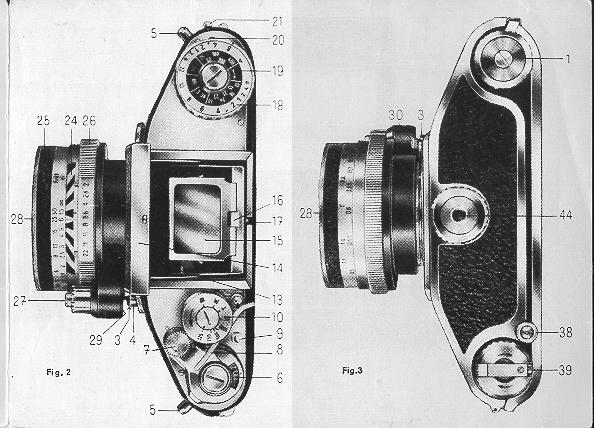EXAKTA VX IIb
This camera manual library is for reference
and historical
purposes, all rights reserved.
This page is copyright© by
 , M.
Butkus, NJ.
This page may not be sold or distributed without
, M.
Butkus, NJ.
This page may not be sold or distributed without
the expressed
permission of the producer
I have no connection with any camera company
On-line camera manual library
Back to main on-line
manual page
If you find this manual useful,
how about a donation of
$3 to:
M. Butkus, 29 Lake Ave.,
High Bridge, NJ 08829-1701
and send your e-mail
address
so I can thank you.
Most other places would charge
you $7.50 for
a electronic copy
or $18.00 for a hard to read Xerox copy.
This will help me to continue to host this site,
buy new manuals, and pay their shipping costs.
It'll make you feel better, won't it ?
If you use Pay Pal, use the link below.
Use the above address for a
check, M.O. or cash.
CLICK HERE TO GO TO EXAKTA VX IIb PDF
MADE FROM FILE BELOW
The important operating controls of the
EXAKTA VX llb
| 1 = Knob for opening
the camera back
2 = Camera-back lock (can be operated only with knob 1)
3 = Shutter release knob
4 = Pivoted shutter-release lock
5 = Eyelets for carrying strap or cord
6 = Frame counter
7 = Frame-counter setting knob
8 = Rapid-wind lever for tensioning shutter and advancing film
9 = Rewind declutching button
10 = Small shutter-speed setting knob
(for speeds from 1/2 to 1/1000 sec., T and B)
11 = Friction dog of rapid-wind lever |
12 = Flash contact "X" (primarily for electronic flash units)
13 = Hood of Finder Hood
14 = Front of Finder Hood
15 = Swing-up focusing magnifier
16 = Handle for swinging the focusing magnifier
17 = Lever for opening the Finder Hood
18 = Large shutter-speed setting knob (for speeds from 1/8 to 12 sec. and also
for delayed-action at 1/4 to 6 sec.)
19 = Film-type reminder disc
20 = Indicator disc for checking film advance
21 = Hinge-pin knob (camera-back hinge)
22 = Flash contact "FP" (for flashbulbs)
|
|
23 = Red aligning dot on camera (for changing lenses)
24 = Depth-of-field scale or automatic depth-of-field indicator
25 = Distance-setting (focusing) ring
26 = Aperture-setting ring
27 = Release knob or rocker of lens
28 = Lens
29 = Red aligning dot on lens (for lens changing)
30 = Lens locking lever
31 = Flash contact "F" (for flashbulbs)
32 = Take-up spool
33 = Chamber for take-up spool or cassette
|
34 = Film-wind sprocket
35 = Film guide runners
36 = Film gate with blind of focal-plane
shutter
37 = Film-cutting knife
38 = Knob of film-cutting knife
39 = Rewind crank
40 = Dog of rewind crank
41 = Chamber for cassette containing unexposed film
42 = Hinged, detachable camera back
43 = Exchangeable film pressure plate
44 = Tripod bush
45 = Penta Prism
46 = Eyepiece of Penta Prism |
We are delighted that you have chosen an EXAKTA VX and we wish you
every success with your new camera.
We would like to advise you however, to read this instruction
manual carefully before you start using your camera. In this way you will obtain
the greatest possible service from it, since you will eliminate from the outset
the possibility of operating it incorrectly, and possibly damaging the
mechanism. The EXAKTA VX is a high-quality precision instrument which con
naturally only be expected to answer all your requirements when it is always
handled correctly.
Fold out the opposite page to the left to reveal the itemized guide
to the camera controls; in this way you can keep constantly referring to this
first illustration whilst you are reading the text.
We recommend you first to get thoroughly familiar with the EXAKTA
VX by practicing with the camera unloaded before you insert a film. Get used to
the operation of the shutter, the technique for opening and closing the camera,
selecting the subject and focusing it, with both the Finder Hood and also the
Pent Prism. Handle the camera just as you would if it contained a film. Lastly
practice inserting a new film; here it is advisable to get accustomed to the
technique by using an old, scrap film.
The EXAKTA VX operates on the single-lens reflex principle, which was first
introduced into miniature photography by Ihagee. Inside the camera there is a
small, pivoted mirror which up to the moment of pressing the release button
reflects the image formed by the taking lens on to the focusing screen. Only in
this way is it possible to eliminate all parallax between the reflex image and
the final picture and so be able to select your subject and focus the image with
complete confidence by means of the reflex viewfinder alone.
Keep in touch with your photographic dealer so that he can keep you constantly
informed about all the latest developments in our production range. Naturally,
we are always ready to give you any advice and information you may need,
whenever you require our assistance on particular points regarding the use of
the EXAKTA.
IHAGEE KAMERAWERK AG
Opening and closing the camera back
 |
Pull out knob (1) as shown in Fig. 5
turn it either to the right or left disengage the catch and then swing open
the camera back (42). To close the back (42), gently press it
shut, then turn the knob (1) either to the right or left until it springs
back to its original position. If you wish to detach the back (42) from the
camera completely, then open the back and withdraw the hinge pin by means of
knob (21). To re-attach the back, hold it in position against the camera and
guide the pin back into the hinge. |
Opening and closing the Finder Hood
The Finder Hood (13) is opened by pressing on the lever (17). To
close the hood, press the front (14) backwards until it locks. The focusing
magnifier (15) can be swung into either the working or rest position by means of
handle (16). For further information on the use of the Finder Hood see page 13.
The image will only be visible on the ground-glass focusing screen in the Finder
Hood when the shutter is tensioned. See next section for instructions on
tensioning the shutter.
Shutter and film advance
 |
These are coupled together, eliminating
double exposures and blank frames. Swing the shutter release lock (4) out of
the way, then release the shutter either by pressing directly on the shutter
release knob (3) or indirectly by depressing the release knob or rocker arm
(27) on the lens. |
The shutter is tensioned and the film wound on by
operating the rapid-wind lever (8). This lever should always be swung right up
to its stop (Fig. 6) and will then spring back of its own accord. It is
impossible to release the shutter before it has been tensioned fully and the
film wound on. Neither can the film be wound on until the shutter has been
released it will not be possible to operate the shutter release when the
rapid-wind lever (8) is at an intermediate point of its travel. Never force the
rapid-wind lever back to its rest position or the mechanism will be damaged.
Should the lever not spring back automatically when
the comer a is empty, then open the back (42) and turn the film-wind sprocket
(34) a little the direction of the exposed-film chamber (33); this will cause
the rapid-wind lever (8) to spring back. Restrain the lever with your thumb
during its return travel.
When you have finished taking pictures, swing the shutter-release lock (4) so
that it covers the shutter release knob (3).
Operating the shutter
 |
Shutter speeds from 1/30 to 1/1000 sec.:
Lift the smaller shutter-speed setting knob (10)-- see Fig. 7--, turn it in the
direction of the arrow until the desired speed value is opposite the setting dot
on the central disc and then allow the knob (10) to spring back. This operation
may be performed either before or after tensioning the shutter.
|
The figures represent fractions of seconds: for example
30 = 1/30 sec. Intermediate speeds cannot be set. Exposures from 1/30 to 1/1000
sec. can safely be taken with a hand-held camera i.e. without a tri pod. Longer
exposu res (see next paragraph) should only be taken when the camera is placed
on a tripod or other firm support.
Time exposures of any desired length: Set the smaller
shutter-speed setting knob (10) to either T or B (either before or after
tensioning the shutter). T = the shutter will open when the release knob (3) or
the release mechanism on the lens is operated and will close again upon a second
pressure. B = the shutter will remain open so long as pressure is maintained
upon the shutter release knob (3) or on the release mechanism of the lens.
Lenses with fully-automatic diaphragms should be adjusted for normal manual
aperture setting; otherwise the diaphragm will open prematurely. When taking
time exposures with the f 2.8/50 mm Domiplan lens, use either the B setting and
if necessary a cable release with locking device, or the T setting and an
additional locking knob for the release rocker. For further details see the
sections dealing with the various lenses pages 7. . .12. The Band T
settings are very important for taking night and indoor exposures.
Shutter speeds from 1/8 to 12 sec.: Tension the shutter. Set
the smaller shutter-speed setting knob (10) to T or B. Turn the larger shutter
speed setting knob (18) in a clockwise direction--see Fig. 8--until it stops;
this tensions the speed-regulating mechanism. Then lift the outer ring of the
shutter-speed setting knob (18), turn it until the red mark is opposite the
desired black speed value and then let the outer ring spring
back. The small figures 8,4 and 2 signify fractions of seconds, e.g. '/a, 1/4
and 1/2 sec. The larger figures from figure 1 to 12 represent whole seconds.
After a fairly brief exposure (e.g. 1/8 sec.) has been used, the
speed-regulating mechanism will be only slightly run down; despite this it
should always be wound right up by turning the knob as far as it will go. Lenses
with fully automatic diaphragms should be set for normal manual aperture
adjustment, to prevent premature opening of the diaphragm. Use an additional
release-rocker locking knob with the Domiplan f 2.8/50 mm lens.
Using the self-timer (delayed
action release)
(a) At shutter speeds from 1/4 to 6 sec.: tension the shutter. Set
smaller shutter-speed setting knob (10) to T or B. Turn the larger shutter speed
setting knob (18) as far as it will go and select the desired red shutter-speed
setting as described above. The small figures 4 and 2 represent fractions of
seconds, 1/4 and 1/2 sec. respectively. The larger figures from 1 to 6 signify
whole seconds (the 3-second setting is represented merely by a dot).
(b) Shutter speeds from 1/30 to 1/1000 sec.: tension the shutter. Do not set the
smaller shutter-speed setting knob (10) to T or B. but to the desired shutter
e.g. '/'as sec. Then rotate the large speed setting knob (18) as far as it will
go and set it to any of the red figures as described above.
The black figures on the larger shutter-speed setting knob (18) indicate
"immediate" exposure settings, whereas the red figures represent delayed-action
exposures (with which the shutter opens approximately 12 seconds after pressing
the release).
Whenever delayed-action exposures are made with lenses which have
fully-automatic diaphragms, these should be set for normal manual aperture
adjustment in order to prevent the diaphragm from opening prematurely. With the
f2.8/50mm Domiplan lens an additional locking knob for the release rocker must
be employed.
For all shutter speeds of 1/8 sec. and slower, a tripod should be used or else
the camera should be placed on a firm support (table wall). The camera should
also be supported suitably to eliminate shake when taking delayed-action
exposures. The tripod bush (44) is in the base of the EXAKTA VX.
Cable releases (with long plunger) may be screwed into the shutter release knob
(3) on the camera or into the release mechanism on the lens. This is
particularly important when using shutter speeds of '/e second and slower and
virtually indispensable when employing the B setting.
Although unintentional double exposures cannot occur; it is, however, possible
to take double exposures on purpose (e.g. for trick photography). After the
first exposure, the shutter can be re-tensioned without winding on the film as
follows: turn the smaller shutter-speed setting knob (10) as far as it will
travel in the direction of the arrow, without lifting it; the knob should be
held to prevent it from springing back. The frame counter (6) always indicates
the number of exposures and will, therefore, record two exposures for an
intentional double exposure.
Operating the lens
 |
The lens (28) is exchangeable: press the
locking lever (3) towards the lens, turn the lens to the left (Fig. 9) until
the red aligning dots (23 and 29) are opposite one another and then lift off
the lens towards the front. To insert a lens, proceed in the reverse
sequence: position the lens with the red dots in line, then turn the lens to
the right until it engages. If, when removing or inserting the
fully-automatic lenses from Jena the adjusting screw of the release knob
(27) should foul any part of the camera, then the remedy is simply to set
the lens to "Automatic" as described on page 10. |
Focusing is performed by turning the distance setting
ring (25); where the ring bears two engraved scales, the lower numerical values
indicate meters, the larger values feet. The focus definition is checked by
observing the ground-glass screen in the Finder Hood or Penta Prism: When using
the Fresnel Lens, critical focusing is done by means of the patterned ring,
situated in the important image center, which don't show the fine structure
lines of the viewfinder-field. When the definition of the reflex image appears
at its sharpest, then the distance of the focused subject (in feet or meters)
will be opposite the red index mark on the scale. This distance is measured from
the subject to the camera back. Cameras fitted with a Fresnel Lens also permit
to use for sharp Focusing the microprism field, and obtain with him a double
focusing-security. Details see on page 16.
The aperture is adjusted by means of the aperture-setting ring (26). The
numerically-smaller aperture values, e.g. 2.8,4, represent relatively large lens
openings these permit fast shutter speeds but give only limited depth of field.
The larger aperture values, e.g. 16, 22 conversely indicate relatively small
lens openings, which require longer exposure times but give greater depth of
field.
 |
What does "depth of field" mean?
Briefly, the situation in which objects at varying distances from the camera
appear uniformly sharp in the picture. More precise information is provided
by the depth-of-field scale (24) on the EXAKTA VX lenses: on either side of
the red distance setting index mark will be found a series of aperture
values (f/Nos.). The distance figures on the feet (or metro) scale which are
in line with the aperture values corresponding to the lens opening actually
used indicate where the depth-of-field "sharp zone" begins and ends.
|
If the aperture figure on one side is opposite the
infinity symbol (00) or even beyond it (reading outwards from the center), then
the depth-of-field zone extends to infinity. The f 2/50 mm Pancolar lens from
Jena is equipped with automatic depth-of-field indicators.
Two examples
Distance setting 00, aperture f 8 = depth of field extends from
about 24 fl (7 m) to infinity; see Fig. 10.
Distance setting 8 ft (2.5 m), aperture f 16 = depth of field extends from about
5 ft (1.5 m) to approx. 36 ft (11 m); see Fig. 11.
Use a large lens opening (= lowest aperture value) for focusing on the reflex
image in order to obtain a brilliant finder image, and then stop down
immediately before taking the picture. This operation does not involve lowering
the camera from the taking position, since the lens is provided with a
fully-automatic spring or pressure diaphragm.
The fully-automatic pressure diaphragm of the Domiplon f 2.8/50 mm lens (Fig.
10):
The fully-automatic pressure diaphragm is used at full aperture for focusing and
observing. Preselect the desired smaller diaphragm aperture by turning the
diaphragm-setting ring. The appropriate numerically-larger aperture value must
be opposite the red triangular mark. It is also possible to set intermediate
values between any two f/stop figures. By pressing on the release rocker the
lens is stopped down automatically; when the release rocker is released, the
diaphragm opens up to the maximum aperture. The rocker should not, however, be
released until the shutter has closed (most important when using the slower
"instantaneous" shutter speeds). For longer
exposures, both when using the-large shutter-speed setting knob (18) and when
employing the B and T settings on the small speed-setting knob (10), and also
for all delayed-action exposures, either of the following procedures should be
adopted:
a) Screw a cable release with a long plunger and time-exposure lock into the
release rocker. In this way pressure can be maintained on the release rocker or
body shutter release for any desired period without having to keep one's finger
constantly on the release (also eliminating camera shake).
b) Alternatively, a special locking knob (available as an accessory) can be
screwed into the release rocker; by propping up the lower part of the rocker the
automatic diaphragm mechanism will be disengaged. The lens is then stopped down
(i.e. a numerically-larger aperture value is selected) by turning the aperture
setting ring. The lens opening will remain stopped down according to the extent
to which the ring is rotated.
Operating the fully-automatic spring diaphragm of the T f 2.8/50 mm (Fig. 11)
and Pancolar f 2/50 mm lenses from Jena (Fig. 12):
Focusing is performed by turning the front, distance-setting ring.
 |
Set the lens either for fully-automatic
spring diaphragm or normal diaphragm setting. When using the fully-automatic
spring diaphragm the release knob (27) on the lens must project, together
with its mount, by about 1 cm or 1/4 in. in front of the black housing. If
necessary press the mount of the release knob gently in the direction of the
camera body and turn it to the right (looking at the camera from the front):
the mount and the release knob will then lock into the "automatic" position. |
The automatic diaphragm mechanism is disengaged as
follows: press the mount of the lens release knob (27) in the direction of the
camera and turn it to the left (looking at the camera from the front); when the
release knob and its mount have been pressed back into the release mechanism
housing and locked in this position, then the diaphragm can be stopped down
(i.e. a numerically-larger f/No. selected by turning the diaphragm-setting ring
(immediately in front of the camera body). The diaphragm will then remain
stopped down according to the amount by which the ring is rotated (this is
important for time and delayed-action exposures). The diaphragm-setting ring has
click stops at all aperture values, including the intermediate values which are
not engraved on the scale. The desired aperture value must be set opposite the
red mark.
In order to ensure that the release button on the camera is always depressed
sufficiently, an adjusting screw is provided on the lower side of the lens
release plunger so that the latter can be set to the required length by means of
a screwdriver. If this adjusting screw should foul any part of the camera when
the lens is being inserted or removed, then the lens need only be reset to
"Automatic".
When employing the fully-automatic spring diaphragm, the lens is always used at
its full aperture for focusing and observing the reflex finder image. It can
then be stopped down to the pre-selected smaller aperture (numerically larger
f/No.) just by pressing the release. This aperture value, at which the exposure
is to be made, is selected by means of the diaphragm setting ring. By pressing
the release knob (27) on the lens, first the diaphragm closes down to the
pre-selected smaller aperture and then the camera shutter is released. By taking
your finger off the lens release knob (27), the
diaphragm automatically opens up to its maximum aperture; the knob should,
therefore, not be released until the shutter has closed completely (this is
particularly important when using the slower instantaneous speed settings). For
taking time and delayed-action exposures the lens should be set for normal
diaphragm operation; the cable release (with long plunger) can be screwed into
the release knob (27) on the lens.
 |
For checking the depth of field during
focusing when the lens is set for automatic diaphragm operation, the release
knob (27) on the lens should be depressed just far enough to close the
diaphragm down to the desired aperture without releasing the shutter. |
The Pancolar f 2/50 mm lens from Jena is provided with an
automatic depth-of-field indicator (see Fig. 12). After the aperture and
distance settings adjusted, the have been adjusted, the two red pointers will
indicate the extent of the depth-of-field range. Observe the positions of the
red indicators and note whether they are in the center of the alternate black
and white guide bands or at the division between two bands. Then follow the
appropriate band until it meets the distance scale the distance figure on the
left will show where the depth of field begins whilst the figure on the right
shows where the zone ends. Practice this operation by setting your own lens as
follows: aperture f 8 distance 5 meters (approx. 15 ft) = depth-of-field range
extends from less than 3 metros (approx. 9 ft) to over 15 meters (actually 23
meters or 76 feet).
Focusing when using infra-red film
When using infra-red-sensitive film first focus the image on the
ground-glass screen. Then note the indicated subject distance (in meters or
feet, or infinity) and rotate the distance setting ring so as to move the
subject-distance figure from the normal red index mark to the red dot either to
the right or to the left of it.
Using the Finder Hood
Upon looking into the Finder Hood (13) of the EXAKTA VX you will
see a brilliant, upright and enlarged image on the ground-glass screen. This
image can be used both for selecting and framing the subject and also for
focusing and checking the depth of field by provisionally stopping down the
lens. The magnifying ground-glass screen fitted in the Finder Hood will
generally give a large enough image for normal view finding purposes, but for
accurate focusing it is advisable to employ the additional focusing magnifier.
The pivoted focusing magnifier (15) will spring into its working position when
the Finder Hood is opened, but can be folded back out of the way by operating
handle (16); see also page 2. For the use of the Fresnel Lens see page 16.
 |
Normally, the EXAKTA VX is held at chest
or shoulder level (Fig. 13). The method of holding the camera when using the
supplementary focusing magnifier is shown in Figs. 14 and 15. When taking
vertical pictures with the Finder Hood it is possible to shoot at right
angle. |
(Fig. 15). This is particularly useful for working
inconspicuously since the photographer can remain in concealment (Fig. 16). The
Penta Prism (see next section) makes it possible to take vertical pictures with
a direct line of vision and also provides a laterally-correct and upright
viewfinder image. The image on the ground-glass screen of the Finder Hood (13)
can also be observed from below when the camera is held above the head. This
will prove very useful when taking pictures over walls or the heads of a crowd.
The EXAKTA VX is a multiple-system camera: the Finder Hood can be detached,
allowing the Penta Prism (45) to be fined red--as explained above. There is also
the Lens Magnifier for close-up photography and photomicrography and the
"Stereflex" Stereo View Finder for 3-dimensional photography; see pages 33 and
35. When exchanging viewfinder units, the Finder Hood (13) must first be closed.
Lift off the Finder Hood by pulling it smoothly upwards (Fig. 17). When
re-inserting the Finder Hood, it must be introduced so that it is exactly
vertical and then pushed down until it locks, never employ force.
Users who normally wear glasses should use their close-up (reading) spectacles
for focusing with the Finder Hood.
Using the Penta Prism
 |
The Penta Prism (45) (see Fig. 1), is
the other principal focusing system of the EXAKTA VX and is primarily
intended for taking pictures of moving subjects such as sporting events (for
which it is virtually indispensable). The Penta Prism (45) is inserted
into the camera and removed in exactly the same way as the Finder Hood. The
camera is always held at eye level when using the Penta Prism; the eyepiece
(46) can be put to either the left or the right eye. The reflex
image on the ground glass screen will invariably be upright and
laterally-correct no matter whether the camera is held horizontally or
vertically; this is particularly useful when taking pictures of moving
subjects since the image in the viewfinder will move in the same direction
as the subject itself.
With very rapidly-moving subjects the camera can thus be "panned" by
swinging it gently in the direction of motion of the subject (as for
example, with racing cars). |
|

|
For, normal horizontal and vertical pictures the
EXAKTA VX when fitted with the Penta Prism (45) is preferably held in the
left hand, using the right thumb and forefinger for focusing. Additional
support can be given with the left hand, employing the left forefinger for
releasing the shutter (Figs. 18 and 19). For taking horizontal pictures the
camera can also be used upside down: press the back of the EXAKTA VX against
your forehead to prevent camera shake. Photographers who normally wear
spectacles should use their distance glasses for focusing with the Penta
Prism. For using the Fresnel Lens see page 16 in detail.
|
|

|
An invaluable accessory for use with the Penta Prism
is the flexible eyepiece cup (Fig. 20): this is fitted to the eyepiece (46)
of the Prism and shields it from distracting stray light. It is also helpful
for spectacle-wearers since vision-correction lenses made by one's optician
can be inserted into the mount, making it possible to focus without wearing
glasses.
|
Exchanging the Ground-Glass Screen and the use of the Fresnel
Lens
The magnifying ground-glass screens for the EXAKTA VX viewfinder
units are interchangeable. Before removing the screen from the Finder Hood, the
hood must be closed.
To remove the viewfinder unit from the camera, grasp the ground-glass screen by
the longer sides and lift it out of the viewfinder. When inserting the
ground-glass screen, it should once again always be grasped by the long sides
(never touch the matted surface) and pushed home between the retaining springs
in the viewfinder. When inserting the screen into the Finder Hood, first close
the hood.
 |
Instead of the ground-glass magnifying
screen, the Fresnel Lens screen can also be used in the Finder Hood, Penta
Prism and Lens Magnifier. This screen contains a split-image rangefinder in
the centre of the image field, which doubles the accuracy of focusing; they
are, therefore, particularly useful for persons with defective vision and
for taking pictures under unfavorable lighting conditions. |
When the lens is focused correctly the two half-images
in the circular rangefinder field must be aligned accurately, without any
displacement, either above and below or alongside each other (Fig. 21). Do not
use a smaller aperture than f 5.6 for focusing, or otherwise one half of the
rangefinder field will appear dark.
The eye used for viewing must be positioned exactly in the centre of the
viewfinder eyepiece when using the Penta Prism, and directly over the centre of
the magnifying lens when using the Finder Hood or Lens Magnifier an oblique
angle of view will result in incorrect focusing and unsharp pictures.
Instructions for use of the Fresnel screen with microprism field see p. 37.
Loading the film
 |
Use perforated miniature film 35 mm in
width. 1.6 meters (5 ft 4 in) of film gives 36 exposures, 24 mm x 36 mm in
size. To ensure trouble-free film transport it is essential to use only
faultless film cassettes When using film from daylight loading spools, these
should only be inserted in cassettes made by the same manufacturers. Remove
the camera back in the manner already described, and pull out the rewind
crank (39) by means of its knob.
|
Place the cassette containing the unexposed film in the
chamber (41), swing out the rewind crank (39) and push it back into the camera
body by depressing the knob; whilst doing so twist the knob gently in the
direction of the arrow so as to make the dog (40) engage with the bar in the
cassette core. Then guide the film over the film guide runners (35) towards the
take-up spool (32); the emulsion side of the film must face the lens. It is
advisable to lay the camera down if possible whilst securing the end of the
film; as shown in Fig. 22, the take-up spool (32) can be removed for attaching
the film: it can be detached easily from the friction dog (11) of the rapid-wind
lever (8). Push the beginning of the film under the clamping spring of the
take-up spool (32) and then wrap one half turn round the core of the spool.,
Replace the take-up spool (32) in the film chamber (33) and turn it slightly in
the wind-on direction so that the friction dog (11) of the rapid-wind lever
couples with the bar in side the spool core and allows the spool to be pushed
right home into the chamber (33). If you leave the take-up spool (32) in the
camera whilst attaching the beginning of the film, then turn it so that the
clamping spring is facing upwards.
 |
Now swing the rapid-wind lever (8) right
up to its stop (if necessary first releasing the shutter) so that the film
is pulled as tightly as possible from the feed cassette, over the film guide
runners (35), thence over the film wind sprocket (34) and on to the take-up
spool (32). The teeth of the film-wind sprocket (34) must engage with the
perforation holes on both sides of the film (Fig. 23). |
Close the camera back, and now expose two blank frames to
wind on the fogged leader length at the beginning of the film: swing the
rapid-wind lever (8) as far as it will go (if necessary first releasing the
shutter), allow it to spring back, then press the shutter (to take the first
blank frame); follow this by swinging the rapid-wind lever (8) up to its stop
once again, allow it to return and then press the release once again to take the
second blank frame. Finally swing the rapid-wind lever (8) as far as it will go
for a third time and let it spring back: an unexposed frame will then be
positioned in the film gate (36). In conclusion, set the frame counter (6) by
turning the setting knob (7) in the direction of the arrow with your index
finger until the stroke-mark immediately before "Fig. 1 " is in line with the
index mark. (The counter operates after each exposure.) The camera is now ready
for action.
In place of the take-up spool (32) an empty standard-type film cassette may be
placed in the take-up chamber. Take care to check the condition of this take-up
cassette thoroughly: the core should move easily within the shell of the
cassette and must not jam (if necessary the friction points of the cassette core
may be lubricated by rubbing them with paraffin wax).
When using a take-up cassette proceed as follows: attach
the leader tongue of the film to the core of the cassette spool, and insert the
cassette so that the friction dog (11) of the rapid wind lever (8) engages with
the bar in the core of the spool. Then check that the film is pulled taught
between the two cassettes and is wound up with its emulsion side inwards (Fig.
24).
 |
It is not necessary to trim the
beginning of the film specially. Any shape of leader can be used with the
take-up spool of the EXAKTA VX, either the narrow tongue provided on
standard commercial cassettes, or, even better, a straight cut-across end as
obtained when cuffing lengths of film from bulk rolls. |
When employing a take-up cassette the film must be trimmed to suit the core of
the cassette spool; for various trimming patterns see Fig. 25.
In order to check that the film is being advanced correctly, observe the
indicator disc (20): the disc with its red mark will rotate when the spool of
the feed cassette is turning. Immediately after loading the film, set the
film-type reminder disc (19) so that you do not forget what type of film is in
the camera (Fig. 26). Turn the reminder disc in the direction of the arrow until
the appropriate reference is opposite the black triangular mark on the shutter
speed setting knob (18). Use the figures from 12 to 30 for black-and-white films
rated in DIN values, the figures from 25 to 400 for black-and white ASA ratings,
the black letters for daylight type color films (C = reversal film, NC for
negative films) and the red letters for artificial light color films (as before,
C = reversal, NC = negative). The example shown in Fig. 26 illustrates the
correct setting for a negative color film intended for use by artificial light.
Changing the film
 |
After taking the 36th exposure it may be
possible to take one or two more pictures before the film cannot be advanced
any further. Whilst advancing the last frame it may happen that the
rapid-wind lever (8) will stop part way through its travel; in this event
press the rewind declutching button (9) and the rapid-wind lever (8) con
then be swung right up to its end-stop. The rapid-wind lever will then
spring back to its rest position. When the take-up spool (32) is being
employed, the film must now be rewound: hold the camera with the left hand
and maintain a constant pressure on the rewind declutching button (9). |
|

|
Swing out the rewind crank (39) and with the right
hand turn it in the direction of the arrow at an uniform and not
excessively-fast speed (Fig. 27). If the film is rewound too quickly, there
will be a danger of electrostatic charging which may cause the appearance of
dark jagged or branching lines on the negatives. It is possible to see
whether the film is being wound back correctly by observing whether the
indicator disc (20) and the screwdriver-slotted spindle of the rapid-wind
lever (8) are rotating.
|
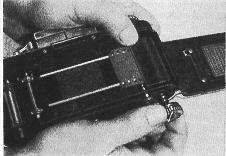 |
When the film is rewound this spindle will stop turning As soon as the rewind
declutching button (9) is released it will spring back info its original
position of its own accord. The camera is then set for advancing the next film.
Now open the camera back, pull out the rewind crank (39) by means of its knob
(Fig. 28), and remove the cassette containing the rewound film from the camera.
Depress the knob on the rewind crank (39) once again to push it back. When using
an empty cassette in place of the take-up spool, it is not necessary to rewind
the film. As soon as the end of the film is reached (when the rapid-wind lever
(8) cannot be operated), cut off the film on the feed side of the film gate (36)
with the built-in film-cutting knife (37). This is done by unscrewing the knob
(38) and withdrawing it by about 1 3/4 inches from the camera body (see Fig.
29); then push knob (38) home once again and screw it up tightly. |
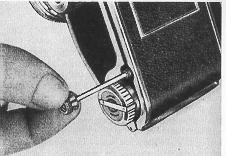 |
By operating the rapid-wind lever and releasing the
shutter twice in succession, the end of the film con be wound right inside the
take-up cassette. The film cutting knife (37) should also be employed in the
manner described whenever it is desired to remove a take-up spool containing a
partially exposed film from the camera.
Taking flash pictures
The EXAKTA VXllb has three synchro contacts for connecting
flashlight units: an X contact (12) for taking open-flash pictures with
electronic flash tubes and flashbulbs, and the FP (22) and F (31 ) contacts for
using expendable flashbulbs in conjunction with the faster shutter speeds. The
FP and F contacts take info account the definite pre-ignition delay encountered
with the various types of flashbulbs. Further details of the shutter-speed
settings required will be found in the following table. The synchro-cable of
standard flashguns or electronic flash units should be inserted into the
appropriate socket on the camera as indicated in the table. It is advisable to
tension the shutter before plugging in the flash unit. Fig. 30 shows the EXAKTA
VX with an electronic flash unit. If a flashbulb should fail to fire, i.e.
through poor contact in the bulb holder, then the bulb should be removed after
the shutter has run off. Never insert a new bulb until the shutter has been
retensioned.
When using electronic flash units, the synchro-cable should be connected to the
X contact (12) and the shutter set to ,/60 sec. or a slower speed. When using
electronic flash units without storage condensers, designed for mains operation
only, the shutter must be set to 1/60 sec.
Tables for connecting flash units to
the three
flash synchro-contacts of the EXAKTA VX llb
shutter sync speed
with flashbulbs

|
open flash table
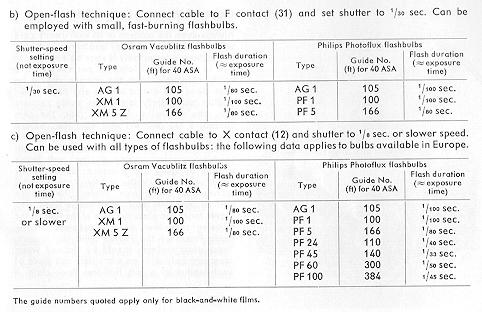 |
Care of the camera and lenses
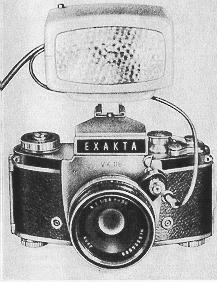 |
Always keep the camera in its ever-ready
case with the lens (or lens cap) and viewfinder unit in position;
alternatively it may be kept wrapped in a fluff-free cloth. All parts which
are easily accessible from the outside should be kept clean and dusted with
a soft brush. This applies particularly to the film guide runners (35), the
film-wind sprocket (34), the film chambers (33 and 41) and also the camera
back (42) including the pressure plate (43). The reflex mirror should only
be dusted when absolutely necessary, using a clean soft brush without
applying any pressure; do not allow the brush to touch the lightly-greased
metal surround of the mirror. Protect the camera against moisture, dust,
wind-borne sand, etc. Never touch the glass surfaces of the lenses, the
focusing magnifier or the eyepiece of the Penta Prism or the mirror with the
fingers. These glass surfaces should be cleaned when necessary only with an
extremely soft piece of wash-leather or a soft, fluff-free linen cloth. It
is highly inadvisable to attempt to interfere with the mechanism of the
camera; repairs should be undertaken only by authorized servicing agencies.
|
Accessories
Accessories increase the versatility of the EXAKTA VX and are
absolutely indispensable for many typos of work.
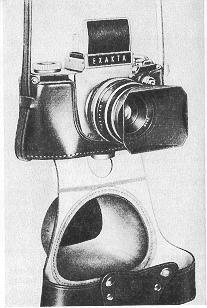 |
Leather Ever-Ready Case (Fig. 31)
This ensures complete protection for the camera whilst it is stored
away or being carried, without affecting its readiness for immediate use.
The tripod screw enables the camera to be mounted on a tripod whilst in
its case.
Lens Hood (Fig. 31 )
Indispensable for protecting the lens against side light and also often
against light shining straight info the lens, particularly when taking
color pictures. It also serves to keep raindrops and snowflakes off the
surface of the lenses. |
The Ihagee Lens Hoods are of the latest rectangular
design, providing a highly efficient shielding effect and are available with M
35.5x0.5 mm thread (37 mm push-on mount diameter), M 40.5 x 0.5 mm thread, (42
mm push-on diameter) and M 49 x 0.75 mm thread (51 mm push-on diameter).
Giant Release Button
This increases the contact area of the camera release button, so
that it con be operated easily even with fingers stiffened by cold or when
wearing gloves. It is invaluable for use in winter. (When using lenses fitted
with a large release knob or release rocker of their own, these practical
devices make it unnecessary to use the Giant Release Button.)
Accessory Shoe (Fig. 30)
The Accessory Shoe is fitted over the Penta Prism eyepiece of the
EXAKTA VX and makes it possible to fit accessories, such as a flash unit,
exposure meter, etc., on to the camera.
Polarizing Filter
A special filter for eliminating reflections from non-metallic
surfaces such as glass, water, varnish, etc. The filter is supplied in a
screw-in mount for the EXAKTA VX lenses. The polarizing filter will only be
effective when the photograph is taken at an acute angle to the reflecting
surface (with glass, at approximately 35°). The filter must be rotated in front
of the lens until a position is found in which the reflection is eliminated; its
effect con be observed in the reflex image. (The exposure must be increased by
2--3 times.)
Special-purpose Lenses
Fully-comprehensive photography is scarcely possible without
special typos of lenses, but only the single-lens reflex camera makes it
possible to exploit fully all their potentialities in such a simple manner. The
reflex viewfinder image of the EXAKTA VX always shows the exact area covered by
the lens as well as the image definition and depth of field.
Wide-angle lenses (with a short focal length) embrace a wide angle of view'
allowing you to get plenty info your picture although every thing appears
relatively small (Fig. 32). They are invaluable for indoor pictures,
architectural work, broad landscape scenes, copying pictures in art galleries,
etc.
EXAMPLES OF LENS LENGTHS
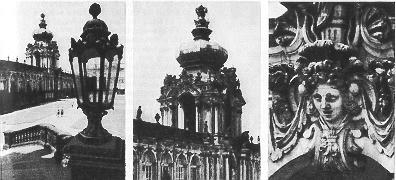
Long-focus lenses include both those of normal construction and also true
telephoto lenses; they have a long focal length and make distant objects appear
nearer, they, therefore, record a relatively narrow section of the subject on a
larger scale (Fig. 32). They also tend to reduce the effects of perspective.
These lenses are frequently used for taking portraits, in child photography, for
photographing sporting events, wild animals and also for landscape work and many
other typos of photography. Fig. 33 shows the EXAKTA VX fined with the popular S
f 4/135 mm lens with fully-automatic pressure diaphragm from Jena.
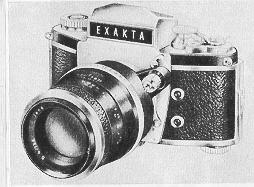 |
If an ultra-high-speed lens is required,
the Bf 1.5/75 mm lens from Jena is also obtainable. The standard lens is
removed in the manner already described and the special-purpose lens fined
in its place. For certain lenses of very long focal length the outer bayonet
of the EXAKTA VX is employed. The distance-setting scales of these special
lenses are also graduated to indicate the distance from the camera back to
the subject. |
Bayonet Adapter Rings and Extension Tubes
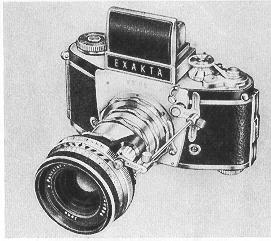 |
The single-lens reflex camera comes info its own when taking close-up
pictures, since in this field, too, the reflex image always shows the exam area
covered by the lens.
The Bayonet Adapter Rings and Extension Tubes may be fitted in any desired
combination between the camera and the lens (Fig. 34) and enable the lens to be
focused down to the very shortest distances. |
The following equipment is available: a Two-in-One Ring providing 5 mm extension
increase, and a set of Bayonet Rings and Extension Tubes (the two bayonet
adapter rings provide 10 mm extension and the tubes an additional 5,15 and 30
mm).
Miniature Bellows Attachment
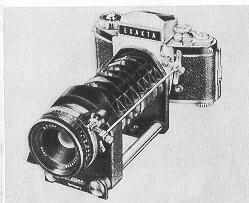 |
This easy-to-carry unit (Fig. 35) is
strongly recommended whenever a large amount of close-up work is to be
undertaken, since it provides a quick method of adjusting the image scale
continuously. The extension of the bellows con be set to any distance
between 35 and 125 mm. This device is primarily intended for taking
hand-held close-up pictures, but con be fitted to any tripod and also to the
Ihagee Copying Stand. The camera bearer of this device allows the camera to
be positioned for both horizontal and vertical pictures. |
Autocouple Extension Release
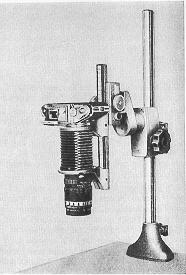 |
In order to be able to use the latest
lenses with fully-automatic spring or pressure diaphragms even when taking
close-up pictures with Bayo net Rings and Extension Tubes or with the
Miniature Bellows Attachment, the extension release should be fitted between
the lens and the camera (Figs. 34 and 35).
Ihagee Vielzweck ("multi-purpose") Equipment
This universal equipment designed on the "ad-on" principle has been devised to
facilitate the most economical employment of the EXAKTA VX in the widest
possible variety of specialized fields. The individual components of the
"Vielzweck" Equipment con be used both singly and in combination with one
another, and it is possible to build up the equipment piece by piece. |
The following units are available:
The Swing Angle Attachment with focusing slide for convenient
close-up focusing when using the Bayonet Adapter Rings and Extension Tubes.
The large Bellows Attachment, for the most efficient production of close-up
pictures, particularly at extremely short subject distances. The bellows
extension is continuously adjustable from 35 to 220 mm, making it possible to
obtain all scales of reproduction available within this range.
The Transparency Copying Equipment for use with the large Bellows Attachment is
employed for making optical duplicates of transparencies. The Copying Stand and
Repro Unit (Fig. 36), obtainable if desired with their own Lighting Equipment,
are designed specially for undertaking copying work, but are also suitable for
use as table stands for other types of close-up photography. With the addition
of special accessories, the Repro Unit may also be employed for
photomicrography.
Microscope Attachment
The Microscope Attachment is designed for connecting the EXAKTA VX
to a microscope and makes is possible to use this camera for photomicrographic
work with the greatest convenience. The attachment is provided with a
quick-change mount and allows the camera to be removed from the microscope with
a single operation whenever photographic recording is interrupted. Even when
taking pictures through a microscope the image con be focused on the
ground-glass screen.
Lens Magnifier
For close-up work and photomicrography a special focusing system is
generally employed, the Lens Magnifier. The actual magnifier is provided by any
of the highly-corrected standard or special-purpose EXAKTA VX lenses.
This gives an enlarged, uniformly and virtually distortion-free
reflex image. If no suitable lens is available or con be spared for this purpose
when undertaking close-up photography, then an excellently corrected Top Lens is
available for use in conjunction with the Lens Magnifier.
Special focusing screens for extreme close-up pictures and photomicrography
In extreme close-up work and when using a microscope, focusing upon
the finest details of the subject is often hindered by the grain of the
ground-glass screen. To overcome this it is possible to obtain focusing screens
with a clear centre spot (3 or 10 mm in diameter) as well as completely clear,
unground lenses.
Focusing is then performed by means of the brilliant aerial image, assisted by a
hairline cross. These focusing screens are standardized to fit all the three
principal focusing units of the EXAKTA VX (with the exception of the Finder Hood
for earlier VX models). The method of exchanging the screen has already been
described (see page 16). Various other special types of screens con be supplied
if required, e.g. with engraved graticules, centimeter or millimeter divisions,
etc.
The Ihagee Macro-Micro Photometer
This device makes it very much easier to determine the correct
exposure when taking close ups and photomicrographs, and also in the optical
copying of transparencies. A selenium barrier-layer cell is placed directly
within the light-path through the lens and so measures the effective
illumination actually entering the camera. The Photometer is used in conjunction
with a standard micro-ammeter or luminous spot galvanometer (effective measuring
range 5...30 ~A, internal resistance 1000~5000 ohms).
Ihagee RB 1 and RB 2 Ring-Flash Units
The Ihagee RB 1 and RB 2 Ring Flash Units are highly up-to-date
universal light sources for close-up photography. They provide constantly
uniform frontal illumination and con be used to overcome the trickiest lighting
problems. They con also be employed together with the various lens-extension
devices for the EXAKTAVX. The Ihagee Kolpofot consists of an RB 1 Ring
Flash Unit combined with the Bellows Attachment and an 4/135 mm S
lens from Jena (which con be stopped right down to f 45). This assembly has been
of immense volume in medical photography, ensuring needle-sharp pictures both of
body cavities (vagina, mouth and pharynx), as well as of the skin, eyes and
ears.
The Ihagee Endoscope Adapter
The Endoscope Adapter makes it possible to take pictures inside
bodily organs (such as the bladder) by forming a connection between the camera
and the viewing instrument or endoscope proper. An "Overrunning Switch
Apparatus" is available to conserve the fife of the lamp used for illuminating
the subject in endoscopic examinations.
Stereo Attachments and Stereo View Finder (Fig. 37)
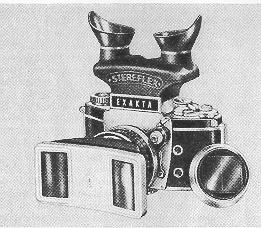 |
These are designed for taking
three-dimensional photographs. The large Stereo Attachment (65 mm
interpupilliary base) is for taking pictures of subjects at distances from
00 (infinity) down to 2 meters (6'/s ft), whilst the small Stereo Attachment
is for use with subjects at distances between 2 meters and 0.15 meters (6 ft
to 6 in) (three supplementary lenses are available for focusing at close
distances with the small Stereo Attachment). Both the Stereo Attachments are
computed for use only with standard 50 mm lenses, and con be screwed into
their front mounts; suitable lenses, include the T f 2.8/50 mm and Pancolar
f 2/50 mm with fully-automatic spring diaphragms from Jena. |
With the aid of an adapter ring these attachments con
also be used on other; lenses of the same focal length and with similar mounts.
After screwing it into place, rotate the Stereo Attachment or its inner section
until the dividing line running through the middle of the reflex image is
exactly vertical, i.e. parallel to the longer sides of the two half-images,
which should already be visible on the reflex image. This vertical adjustment
con be simplified by checking that a selected point in each of the two
half-images is at an identical distance from the lower edge of the image frame.
The large Stereo Attachment con then be locked by turning the knurled locking
ring in the opposite direction. Focusing is performed by means of the reflex
image in the usual manner. When using the Stereo Attachment the normal exposure
should be increased by 1.5 times (with landscapes and similar subjects) to 1.8
times (for indoor pictures). It is, therefore, necessary to re-set the lens in
order to increase the lens opening by an appropriate amount. Since the two
half-images must always be positioned alongside one another, the EXAKTA VX must
always be held horizontally; consequently the stereo pictures will always be
vertical in format. In order to assess the effect of a three dimensional picture
before releasing the shutter, it is possible to fit the fourth viewfinder system
of the EXAKTA VX, the "Stereflex" Stereo View Finder. This will provide a
stereoscopic effect in the actual viewfinder image. The Stereflex con also be
employed as a simple stereo slide-viewer; for this purpose the ground glass
screen must be removed from the Stereo View Finder by gripping the longer sides
of the screen and withdrawing it from the retaining springs. The clip-on frame
supplied is then fined on the View Finder, ensuring that the small locating pins
engage with the slots in the retaining springs.
Instructions for use of the Fresnel screen with microprism field
Instead of using the ground-glass screen in the viewfinder units
(with the exception of the stereo-viewfinder) the fresnel screen with microprism
field (Fig. 19) may by used. When focusing on this screen, particular use con be
made of the patterned ring, the centre of which is made up of a microprism
surface in order to increase the accuracy of focusing. The extra brilliant image
which is visible in this central circular field serves for focusing in the same
way as the image on a ground-glass screen, but with the microprism, in correct
focusing will result in an image which is blurred to a greater degree. Therefore
focusing is easier. faster, and more accurate. The lens will be correctly
focused when the image in the microprism is at its sharpest. It is, however,
absolutely essential to focus at full aperture; with apertures of 5.6 and
smaller, the image in the microprism field will appear relatively sharp even
with an incorrectly focused lens, and this will obviously lead to unsatisfactory
results.



